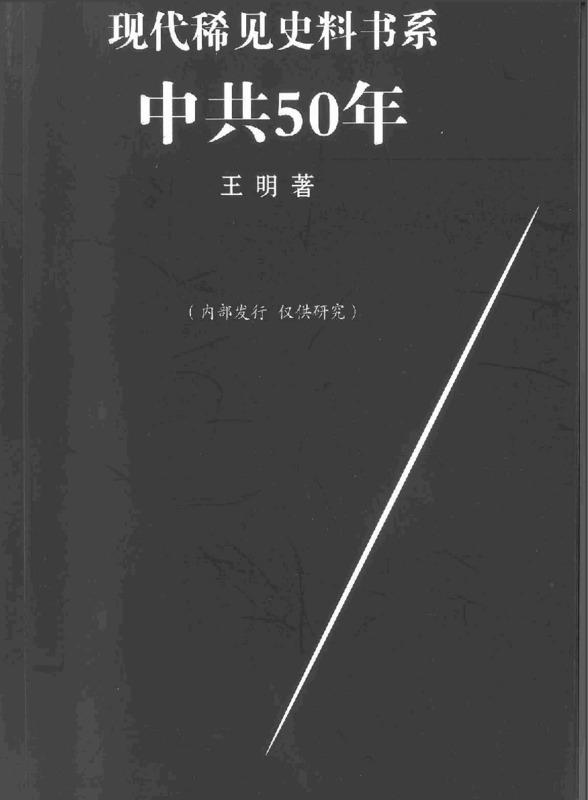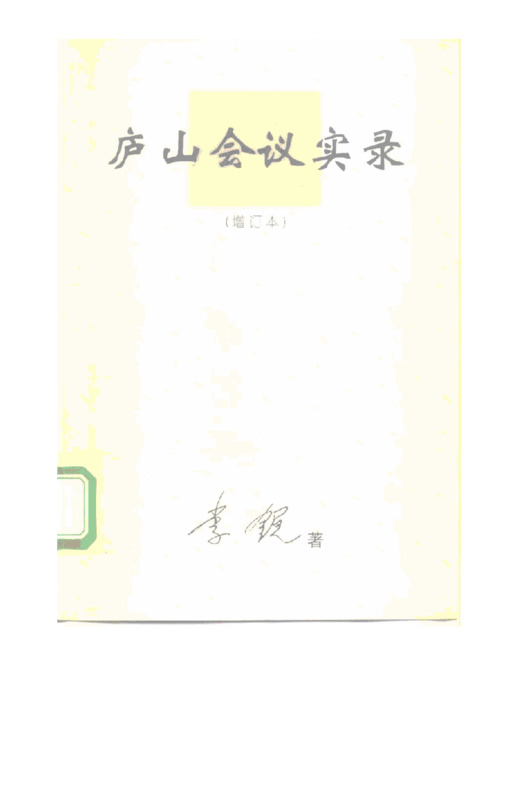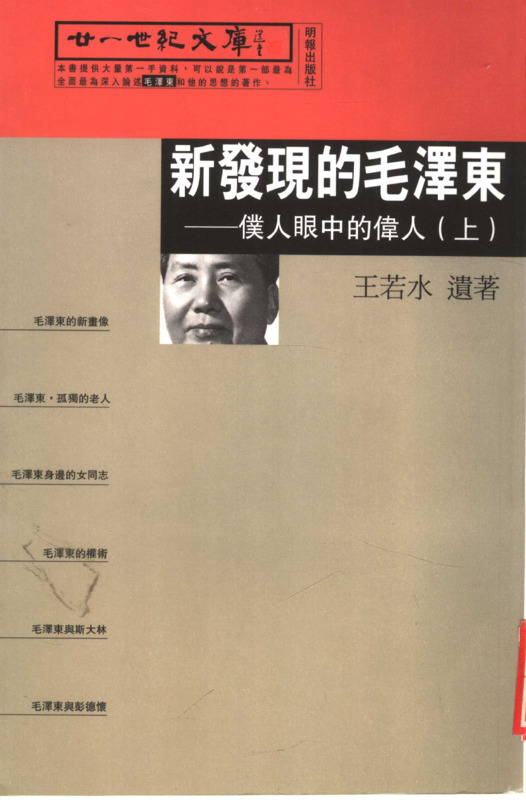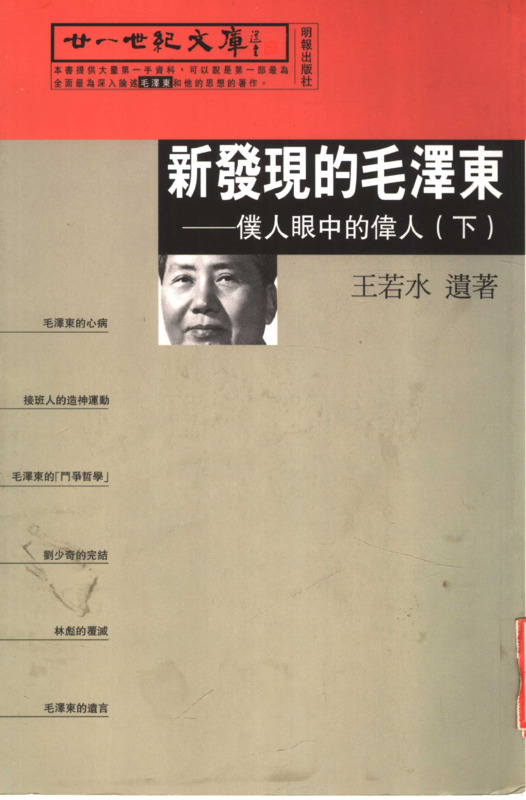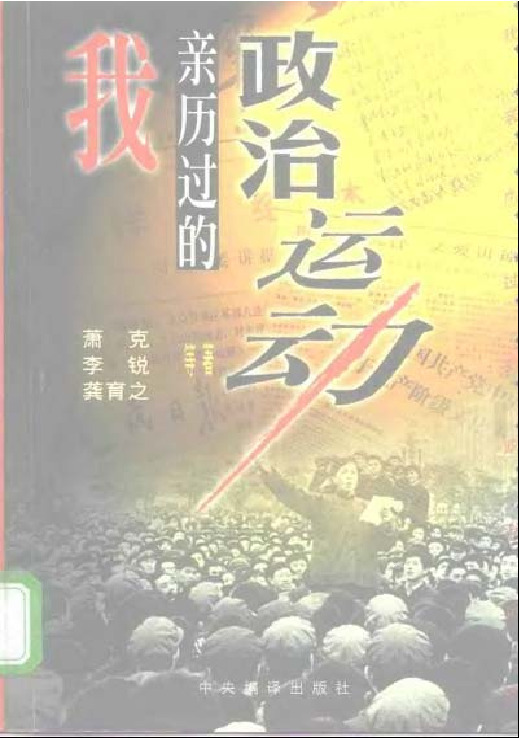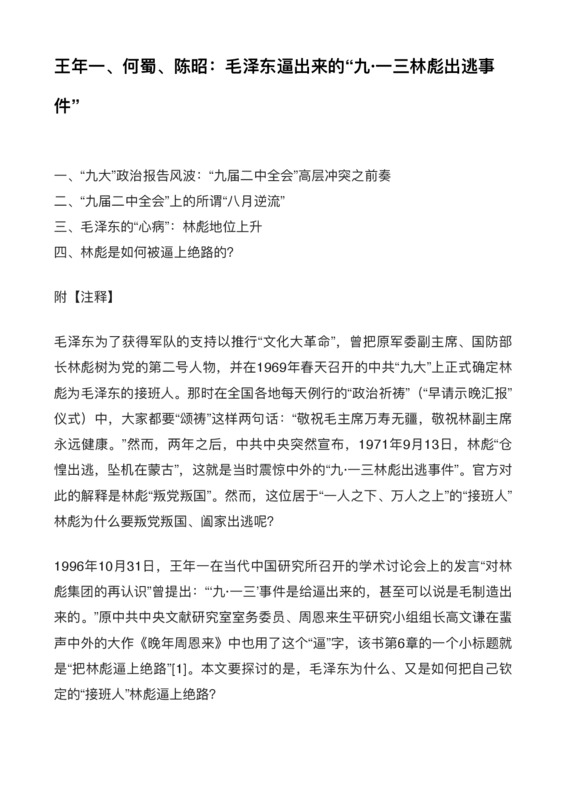Explore the collection
Showing 16 items in the collection
16 items
Book
China's "Left Scourge"
The author of this book, Lu Jianhua (pen name Wen Lu), was a former member of the Chinese Academy of Social Sciences who published this book in 1993. He was sentenced to 20 years in prison in 2005 for "allegedly leaking state secrets" in connection with the "espionage case" involving journalist Cheng Xiang.
Book
Fifty Years of the Chinese Communist Party
The author Wang Ming was an early member of the Communist Party of China (CCP) and the first of the "28 and a half Bolsheviks," who lost power after the Yan'an Rectification and were gradually marginalized by Mao. After the Yan'an Rectification, the Internationalists, led by him, lost power in the party. He was gradually ostracized by Mao Zedong, who expatriated him to the Soviet Union in 1956. In his book, Wang Ming recounts his decades-long feud with Mao. It provides a fascinating insight into the early history of the CCP.
Book
Long Memories after the Hijacking -- Chronicle of Ten Years of Turmoil
The author of this book, Mu Xin, was an early member of the CPC and served as chief editor of "Guangming Daily" in the 1950s. At the beginning of the Cultural Revolution, he was a member of the Central Committee's Cultural Revolutionary Group. In 1967, he was defeated and imprisoned in the Imperial Prison (Qincheng Prison). This book was published in Hong Kong in 1997. Because of the author's status, this book is helpful for understanding high-level circumstances during the pre-Cultural Revolution and early Cultural Revolution period.
Book
Lushan meeting factual record
This book is a historical record of the 1959 Lushan Conference written by Li Rui. Based on the author's personal experience and the literature of the relevant departments of the Communist Party of China, the author has recorded the important points and events before and after the meeting. The first edition of this book was published in April 1989 by the Spring and Autumn Publishing House and Hunan Education Publishing House in mainland China; the updated edition was published in June 1994 by Henan People's Publishing House.
Book
Man-Made Disasters: The Great Leap Forward and the Great Famine.
The author of this book, Ding Shu, is a Chinese scholar living in the United States. Published in 1991 by the Hong Kong-based "Nineties Magazine", this book is the first monograph on the Great Famine in China. It has been described by some scholars as the cornerstone of the study of the Great Famine in China. The book was later updated and reprinted. The book starts from the cooperative movement and moves on to the Great Leap Forward, the Great Iron and Steel Refining, the People's Commune, the Satellite Release and the Great Communist Wind; then, it turns to the Lushan Conference against right-leaning as well as the 7,000 People's Congress in 1962. The author collected almost all the information that could be collected at that time and summarized it to describe the situation of this great famine and its causes and consequences. The content of this book is from the website of the Chinese blog "Bianchengsuixiang" (编程随想).
Book
Mao: The Unknown Story
This book presents the dramatic life of Mao Zedong, revealing a wealth of unheard-of facts: why Mao joined the Communist Party, how he came to sit at the top of the Chinese Communist Party, and how he seized China step by step. Writers Jung Chang and her husband Jon Halliday took ten years to complete this book, interviewing hundreds of Mao's relatives and friends, Chinese and foreign informants and witnesses who worked and interacted with Mao as well as dignitaries from various countries.
Purchase link:https://www.amazon.com/Mao-Story-Jung-Chang/dp/0679746323.
Book
Newly Discovered Mao, The: Volume I
Author Wang Ruoshui spent his early years studying philosophy at Peking University. He served as deputy editor-in-chief of the Communist Party newspaper “People's Daily” and was able to participate in high-level ideological discussions, gaining a deep understanding of Mao Zedong as a person and of his thought. He was one of the rare intellectuals within the CCP system who had an independent personality as well as the ability to think for himself. After his death from cancer, his wife, Feng Yuan, helped put together this posthumous book. Published by Ming Pao Press in 2002, it has been described as "the first and most comprehensive and in-depth discussion of Mao Zedong and his thought."
Book
Newly Discovered Mao, The: Volume II
Author Wang Ruoshui spent his early years studying philosophy at Peking University. He served as deputy editor-in-chief of the Communist Party newspaper "People's Daily" and was able to participate in high-level ideological discussions, gaining a deep understanding of Mao Zedong as a person and his thought. He was one of the rare intellectuals within the CCP system who had an independent personality as well as the ability to think for himself. After his death from cancer, his wife, Feng Yuan, put together this posthumous book. Published by Ming Pao Press in 2002, it has been described as "the first and most comprehensive and in-depth discussion of Mao Zedong and his thought.
Book
Personal experiences of political movements
This book is a collection of many authors, most of whom were former senior officials of the Communist Party of China, such as Li Rui, Xiao Ke and others. Through the author's recollections, we can learn about the political movements of the Mao Zedong era, including the Cultural Revolution, the Anti-Rightist Movement, etc., as well as the details of many unjust cases, such as the Hu Feng case, which is quite convincing. This book was published by the Central Compilation and Translation Bureau Press in mainland China in 1998.
Book
Thirty Years of New China
Tang Degang is a historian and biographer who specializes in oral history. In the latter half of his life, he settled in the United States and taught at Columbia University and the City University of New York. In the field of history, he put forward the "Three Gorges Theory of History", which divides the change of Chinese social system into three major stages: feudalism, imperialism, and civil rule. The book was originally titled <i>Mao Zedong's Dictatorship, 1949~1976</i>, but was renamed <i>Thirty Years of New China </i> when it was released on the mainland.
Article
Wang Nianyi, He Shu, and Chen Zhao: Mao Zedong's "September 13th Lin Biao Escape Incident"
Wang Nianyi is an expert on the history of the Cultural Revolution in China. Early on, he suggested that Lin Biao's defection was forced by Mao Zedong. This has long been considered a taboo view in China.
Book
Who is the New China
Author Xin Hao Nian tries to analyze the modern history of China since the Xinhai Revolution. He pointsout that the People's Republic of China (PRC) is a restoration of the authoritarian system, and the Republic of China (ROC) represents China's road to a republic. The first volume of the book defends and clarifies the history of the Kuomintang (KMT), arguing that the KMT is not a "reactionary faction" as claimed by the CCP. The second volume criticizes the revolution and history of the CCP. The book was first printed in 1999 by Blue Sky Publishing House (USA) and reprinted in June 2012 by Hong Kong's Schaefer International Publishing. It is banned on the mainland.
图书
The 300,000-Character Letter by Hu Feng
The “300,000-Character Letter,” formally titled “Report on the Practice of Literature and Art Since Liberation,” was a lengthy article submitted by Hu Feng to the Central Committee of the Chinese Communist Party in 1954. This report, approximately 300,000 characters long, thus earned its popular name. It collectively reflected Hu Feng’s views and dissatisfactions regarding the cultural and artistic policies and the state of literature and art since 1949.
The core of the report was Hu Feng’s critique of the prevailing problems in the literary and art circles at the time, such as dogmatism, sectarianism, and formulaic, conceptual approaches. He believed these issues stifled the vitality and creativity of literature and art, hindering their healthy development. In the document, Hu Feng proposed that literary and art workers should have greater creative freedom, emphasizing the subjectivity and authenticity of artistic creation, and arguing that art should not simply be reduced to a tool for political propaganda. He particularly opposed the then-prevalent rigid understanding that “art is subordinate to politics,” advocating that literature and art have their own inherent laws and independent value.
The submission of the “300,000-Character Letter” did not receive a positive response from the Central Committee; instead, it was seen as a challenge to the Party’s literary and artistic line. In 1955, Mao Zedong deemed it to be in opposition to his “Talks at the Yan’an Forum on Literature and Art,” leading to the infamous case of the “Hu Feng Counter-Revolutionary Clique,” where he, along with thousands of others, was accused of forming an “anti-Party clique” and subjected to decades of political persecution. It was not until 1980 that Hu Feng was rehabilitated.
图书
The Memoirs of Hu Feng
The Memoirs of Hu Feng is a work based on the oral accounts of the literary theorist and poet Hu Feng (1902-1985) in his later years, compiled and edited by others. This memoir primarily chronicles Hu Feng’s eventful life, from his early experiences and studies in Japan to his involvement in the left-wing literary movement and his interactions with cultural figures like Lu Xun. It also covers his entanglement in the “Hu Feng Incident” in 1955 and his subsequent decades of political persecution.
The memoir, from a first-person perspective, offers a detailed review of the significant historical events and ideological journey throughout Hu Feng’s life. It not only showcases his dedicated exploration of literary theory and his steadfast adherence to ideas like the “subjective fighting spirit” but also includes a wealth of first-hand materials, such as his correspondence with friends and comrades, and his evaluations of the prevailing literary trends and figures of the time. The book also provides readers with a valuable perspective for understanding the “Hu Feng Incident.”
图书
The History of the Wrongful Persecution of the Hu Feng Clique
Li Hui’s The History of the Wrongful Persecution of the Hu Feng Clique is a meticulously researched book that delves into the “Hu Feng Incident,” the first political campaign targeting intellectuals in the Mao era.
The book details how Hu Feng and his followers were accused of organizing an “anti-Party clique” in 1955, leading to decades of political persecution. Through extensive research of archival documents, memoirs of those involved, and interview materials, Li Hui uncovers all aspects of the “Hu Feng Incident”—its origins, development, and its profound impact on the fates of individuals and on society. The book not only explores the complex political factors and ideological conflicts behind the incident but also analyzes the tension and predicament in the relationship between intellectuals and state power during that specific period.

